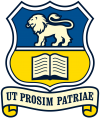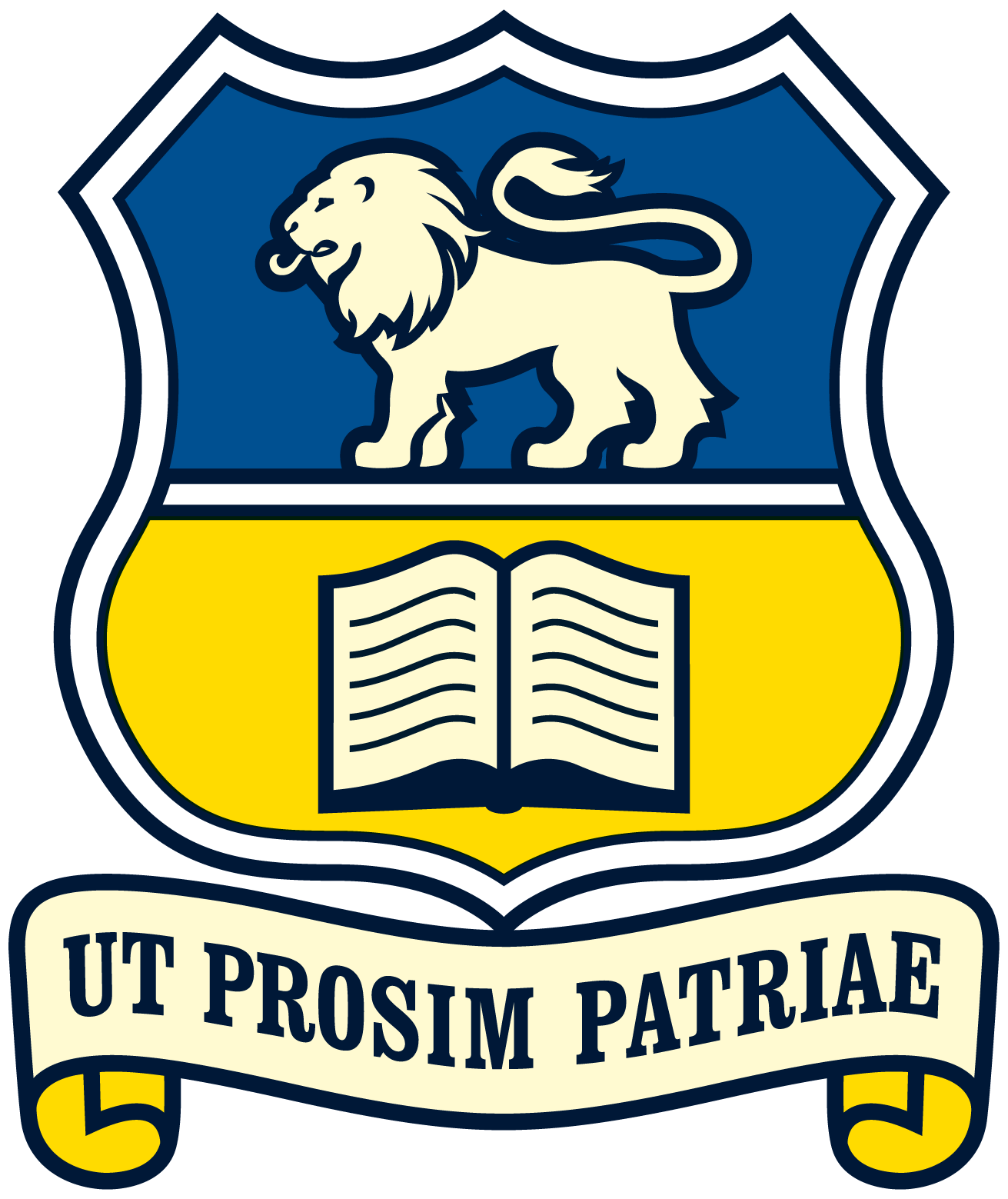Our Tikanga / Values

Behavioural Expectations
Thames High School | Te Kura Tuarua o Te Kauaeranga is committed to encouraging and acknowledging positive behaviour and responding to other behaviour in a proactive and effective manner, such that behaviour is changed.
The foundation of our behavioural expectations are Ngā Pou Tikanga | Our Values:
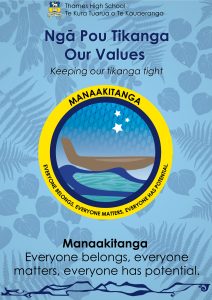 | 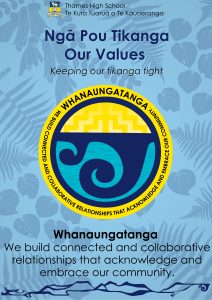 | 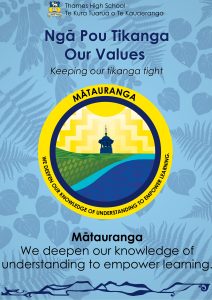 | 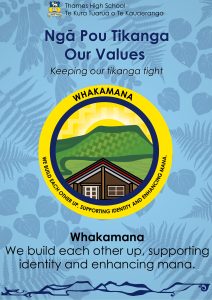 | 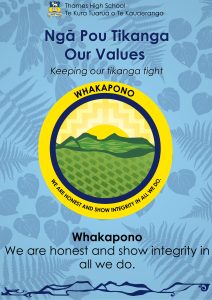 |
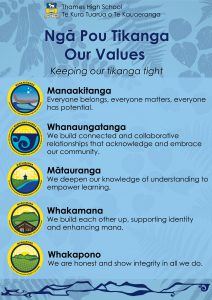
Kaiako/Teachers and other adults will explicitly teach, remind, encourage, and acknowledge positive behaviour.
Acknowledgements may include positive recognitions (merits), small rewards / draws, certificates, praise emails and other ways to show taiohi/students we recognise upholding Our Tikanga.
Thames High School has a Matrix of Expectations based on Positive Behaviour for Learning School Wide (PB4L).
Here is a simplified version:
Responding to behaviour – consequences
Managing behaviour relies on consistently applying both our school’s behaviour expectations and strategies to promote positive student behaviour. We also expect high standards of conduct from our school community, which includes modelling good behaviour for students.
Our response to behaviour is consistent with Ministry of Education Guidelines for Behaviour Management.
At Thames High School kaimahi/staff and all adults, including relievers, coaches, and tutors etc, maintain positive learning environments and relationships with students.
We make a clear statement of acceptable and unacceptable behaviour known to all staff, parents, and students.
- All members of the school, including the students themselves, have a responsibility to recognise bullying and to act when they are aware of it happening.
- We consistently apply our Behaviour Management Process in all cases of unacceptable behaviour, to always maintain the dignity/mana of the taiohi/student.
- Staff manage challenging behaviour and use de-escalation techniques if a student’s behaviour is becoming out of control and/or poses a danger to themselves or others. Physical restraint is used only in an emergency, and only according to Ministry of Education physical restraint guidelines
- Individual programmes and strategies for students with behaviour difficulties are devised with parents and staff, and outside agencies if necessary, and these students may be dealt with outside the school’s behaviour plan.
- The school follows the procedures outlined by the Ministry of Education for the stand-down, suspension, or exclusion of students, in cases of extreme and persistent behaviour.
- Our school follows the same behaviour management and disciplinary procedures for international students as for domestic students. Any additional or different conditions for international students (such as around accommodation, attendance, or visa requirements) are outlined in the enrolment contract.
Parents’ concerns about student behaviour
If a parent has a concern about an incident at school, the parent should contact the school and the school will deal with the concern. The school policy is that parents should not approach other students or parents about school behavioural incidents. This also applies to incidents that occur out of school time or off school grounds but when students are still connected with the school e.g. at EOTC events, while wearing school uniform, or travelling to and from school.
Changing Behaviour
When taiohi/students behave in ways that do not reflect Our Tikanga, we must respond in such a way to change this behaviour.
Our model of responding behaviour is based on the premise that ‘all we do is behave’, and that behaviours are typically caused by something, are purposeful and contextual (i.e. vary based on the situation) and that future behaviour depends on what happens following a behaviour.
This means that behaviour may be reinforced (be more likely to happen again) or weakened (be less likely to happen) by the consequences that follow. We aim to ensure our consequences discourage unwanted behaviours and reinforce positive behaviours. This requires teaching young people new ways to behave and to address the reasons for their behaviour.
Below is a summary of the behaviours that contravene Ngā Pou Tikanga | Our Values.
Unacceptable Behaviour
The following behaviours contravene Ngā Pou Tikanga | Our Values and are unacceptable. This list is not exhaustive; additional behaviours may be deemed unacceptable at the discretion of the Principal, Deputy Principals, or the Board, especially where actions are inconsistent with our values.
Unacceptable Behaviours Include:
- Disrespect toward self, others, or property
- Harassment or bullying, including verbal, physical, cyber, or social, that may cause harm or distress to an individual or group. This includes behaviour that discriminates based on disability, race, religion, gender, or sexuality.
- Inappropriate use of property or technology, including misuse of personal or others’ belongings, or failure to follow the school’s Cyber Safety Agreement.
- Defiance or non-compliance, including refusal to follow reasonable instructions from staff.
- Disruption of learning for self or others.
- Inappropriate physical contact.
- Offensive or abusive language or gestures directed at others (students, staff, or members of the public).
- Incorrect uniform or personal presentation. Refer to the guidelines on uniform.
- Kirpan: No kirpan may be worn while in school uniform, at school, or during school events. A miniature symbolic kirpan may be worn on a neck chain provided it is not visible.
- Lack of preparedness for learning or school activities (e.g., not bringing the required materials).
- Punctuality issues, including being late to school or class.
- Dishonesty, including lying, withholding information, forgery, or misrepresentation.
- Truancy or being in out-of-bounds areas without permission.
- Vandalism or theft, including deliberate damage to or unauthorised removal of school or personal property.
- Aggressive or confrontational behaviour.
- Violence or assault, whether physical or verbal.
Possession, Use, or Influence of Prohibited Items or Substances
Students must not use, possess, or be under the influence of any item or substance that may cause harm, offence, or damage to people or property. This includes, but is not limited to:
- Wearing clothing or displaying symbols, gestures, or language associated with gangs* (e.g., bandanas, tags, or gang signs).
- Tobacco or vaping products (including e-cigarettes and paraphernalia)
- Alcohol
- Drugs (including synthetics or drug-related items)*
- Weapons or replica weapons*
- Lighters, matches, lasers, offensive media* or images*
- Other harmful or offensive items
*Note: These items breach New Zealand law and will be treated will generally be reported to Police.
Other Prohibited Items or Behaviours
- Chewing gum is not permitted due to hygiene and property damage concerns.
- Permanent markers (e.g., Vivid pens) are banned due to their potential for and association with graffiti and tagging. Personal items such as bags, pencil cases, and exercise books must not be tagged or defaced.
Drugs, Alcohol, and Harmful Substances
No student may use, possess, or be under the influence of drugs, alcohol, or other harmful substances while under the school’s jurisdiction (on-site, off-site activities, or while in uniform).
Any suspected breach will be referred to a Deputy Principal and/or the Principal. The response will follow the school’s behaviour management plan and the Ministry of Education’s stand-down, suspension, and exclusion procedures. Parents/caregivers will be informed, and where appropriate, the relevant authorities (e.g. Police).
Where possible and appropriate, the school may offer support or organise intervention in consultation with the student’s parents or caregivers.
Here is a revised and restructured version of your Consequences for Unwanted Behaviour section, organised into clear tiers of seriousness and support, with appropriate tier names. The structure uses positive, restorative framing while making the escalation of seriousness and consequences clear.
Responding to Unwanted Behaviour – Tiered Approach
At Thames High School | Te Kura Tuarua o Te Kauaeranga, Ngā Pou Tikanga | Our Values guide expectations for student behaviour. They provide the foundation for a safe, respectful, and positive learning environment, where everyone has the opportunity to succeed.
Our behaviour expectations are grounded in our values of manaakitanga (everyone belongs, everyone matters, everyone has potential) and whakamana (we build each other up, supporting identity and enhancing mana). These values drive our focus on corrective and restorative practices.
While the aim is to restore and re-engage, students must also understand that disciplinary consequences—where necessary—are part of maintaining a respectful and inclusive school culture.
Guiding Principles
- Behaviour is assessed by what occurred, the harm caused or potential harm, and the level of support required.
- Each situation is considered in context. The same behaviour may fall into different tiers depending on seriousness, frequency, or intent.
- Consequences aim to correct and support – not punish – while protecting the rights of others to learn and feel safe.
- Consequences should be logical, consistently applied, fair, timely and educative. Consequences can be natural ( a direct result of the behaviour) and/or logical (related to the behaviour, and aimed at correcting the behaviour). For example:
- a student forgets to bring their lunch, then the natural consequence is they will feel hungry.
- a student is late to class, a natural consequence is they miss the start of the lesson and then do not know what the goal of the day is, and a logical consequence is the teacher has the student stay behind to catch up on the missed work or make up the time lost.
Behaviour Response Tiers
| Tier | Level Name | Who Manages It | Focus |
|---|---|---|---|
| Tier 1 | Guided Management | Classroom Teacher / Activity Leader | Early intervention and self-reflection |
| Tier 2 | Supported Behaviour Change | Dean / Kaiāwhina / HOD, with DP support | Structured support and accountability |
| Tier 3 | Intensive Support & Disciplinary Action | Deputy Principal / Principal / Board | Serious or repeated harm requiring formal response |
Tier 1 – Guided Management
Lower-Impact Behaviours
Managed by classroom teacher or supervising adult
These are typically isolated or lower-level behaviours that interrupt learning, show lack of preparation, or breach basic expectations. The goal is early correction through reminders, modelling, and W.A.R.M. conversations that keep small issues from escalating.
Examples:
- Lateness to class or school
- Incorrect uniform or grooming
- Disruptive behaviour in class
- Not bringing required materials/gear
- Mild non-compliance or refusal
- Inappropriate language or gestures
- Low-level put-downs/disrespect
- Being in an out-of-bounds area
- Misuse of property or technology
Possible Responses:
- Reminder / redirection / re-teaching of expectations
- Verbal or written apology
- W.A.R.M. restorative conversation
- Confiscation of items (e.g. phone misuse)
- Correction of issue (e.g. uniform)
- Class-based imposition/task
- Temporary removal from class (time-out)
- Contact with home by teacher/adult
W.A.R.M. Conversation Prompt:
- What happened? What were you thinking?
- Affect: Who was affected? How?
- Repair: What needs to be done to put this right?
- Move forward: How can we stop this happening again?
Tier 2 – Supported Behaviour Change
Ongoing, Repeated, or Higher-Impact Behaviours
Managed by Kaiāwhina | Dean, or HoD with SLT support
These behaviours may require removal from the learning environment, structured follow-up, and targeted support. They may be significant first-time incidents or repeated Tier 1 issues that have not improved despite earlier intervention.
Examples:
- Sustained non-compliance or defiance
- Aggression or threatening behaviour
- Dishonesty (e.g. forgery, cheating)
- Bullying or harassment (verbal, physical, online)
- Inappropriate or offensive language/gestures
- Fighting
- Truancy / repeated lateness
- Possession or use of cigarettes or other banned items
- Repeated Tier 1 behaviours
Possible Responses:
- Behaviour investigation (e.g. gathering statements)
- Parent/caregiver contact or meeting
- Behaviour agreement / Daily Progress Report
- Referral to Guidance Counsellor
- Restorative meeting / circle
- Detentions for reflection / restorative tasks
- Community service (e.g. gum scraping, rubbish duty)
- Temporary loss of privileges (e.g. event participation)
Tier 3 – Intensive Support & Disciplinary Action
Serious or Repeated Harmful Behaviours
Managed by Deputy Principal, Principal, and Discipline Committee (as needed)
These behaviours seriously breach safety, wellbeing, or legal standards, or show repeated disregard for previous interventions.
Examples:
- Serious verbal or physical assault
- Use, possession, or supply of drugs/alcohol or harmful substances
- Possession or use of weapons (including replicas)
- Repeated bullying, harassment, or intimidation
- Ongoing truancy or disengagement
- Major theft or vandalism
- Escalating/repeated Tier 2 behaviours
Possible Responses:
- Referral to DP or Principal
- Notification of Police or other agencies (e.g. Oranga Tamariki)
- Individual Behaviour Plan
- Managed return-to-school plan
- Counselling or external support
- Consideration of alternative education pathways
- Stand-down or Suspension (following MoE guidelines)
- Referral to the School Board Discipline Committee
Responses to behaviour (used across all tiers as appropriate)
- Investigation (statements, interviews)
- Parent/caregiver meetings
- Confiscation or restricted access (e.g. technology)
- Restorative conversations or meetings
- Reflection or restitution tasks
- Removal from activities / withdrawal from class
- Referral for support (internal or external)
- Stand-down, suspension, or exclusion (Tier 3 only)
Alternatives to Stand-downs and Suspensions
In line with Ministry of Education guidance, stand-downs and suspensions are used only as a last resort when other interventions have not been effective or when the behaviour is of such seriousness that exclusion from school is required to ensure safety or restore order.
Wherever possible, Thames High School | Te Kura Tuarua o Te Kauaeranga seeks alternative, supportive responses that keep ākonga engaged in learning. These may include: behaviour monitoring reports, individual behaviour plans, restorative meetings or conferences, counselling support, targeted mentoring, whānau hui, external agency involvement, or short-term behaviour support programmes. Each situation is considered individually, and further alternative supports may be developed in partnership with whānau and relevant professionals.
The Kaiāwhina | Deans, Senior Leadership Team and Counsellor(s) are always available for consultation regarding student behaviour, and any support parents / caregivers may need.
Stand downs and suspensions from School
A student involved in continued disobedience (repeated misbehaviour) or gross misconduct (unacceptable / serious behaviour that is a dangerous or harmful example or could cause harm to themselves or others) may be stood down or suspended by the principal (or person with delegated authority). [(Section 80(1) / 80(2) of the Education and Training Act 2020 (‘the Act’)]
While the school considers suspension as a last resort, it is about weighing up the individual right to attend and the requirement to ensure the school “is a physically and emotionally safe place for all students and staff” (Section 127 (1)(b) of the Act)
- A Stand-down is the formal removal of a student from school for a specified period, not exceeding 5 school days in any one term and 10 days in total that year.
- A Suspension: should a student either exhaust their 5 days in one term or 10 days of stand-down in a year and/or engage in serious misbehaviour, the student may be suspended from School. A suspension is also the formal removal of a student from school until the school board (Disciplinary Committee) decides the outcome at a suspension hearing that must be held within 7 school days (Section 81 of the Act)
The Disciplinary Committee of the school board considers the suspension and can make one of four decisions: reinstate, reinstate with conditions, extend the suspension conditionally or exclude the student (if under 16 years), or expel the student (if over 16 years of age).
Students who are stood-down or suspended may be required to attend school for counselling or to access an individual educational programme being provided during the period of stand-down or suspension, where appropriate.
More information for parents about stand-downs and suspensions (Ministry of Education)


